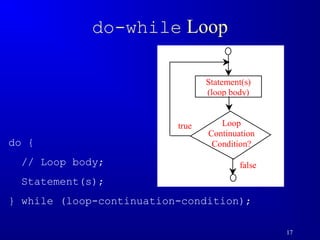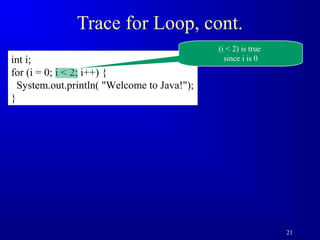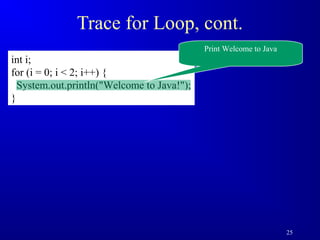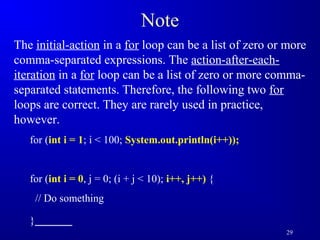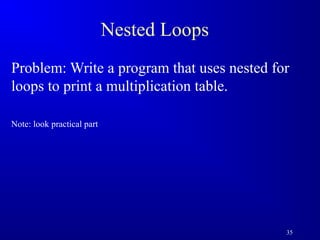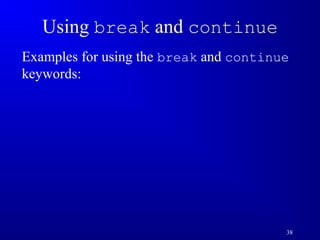Java Programming: Loops
- 1. 1 SSttrruuccttuurree pprrooggrraammmmiinngg JJaavvaa PPrrooggrraammmmiinngg –– TThheeoorryy CChhaapptteerr 44 LLooooppss FFaaccuullttyy ooff PPhhyyssiiccaall aanndd BBaassiicc EEdduuccaattiioonn CCoommppuutteerr SScciieennccee BByy:: MMsscc.. KK aarrwwaann MM.. KKaarreeeemm 22001144 -- 22001155
- 2. 2 Motivations Suppose that you need to print a string (e.g., "Welcome to Java!") a hundred times. It would be tedious to have to write the following statement a hundred times: System.out.println("Welcome to Java!"); So, how do you solve this problem?
- 3. 3 Opening Problem System.out.println("Welcome to Java!"); System.out.println("Welcome to Java!"); System.out.println("Welcome to Java!"); System.out.println("Welcome to Java!"); System.out.println("Welcome to Java!"); System.out.println("Welcome to Java!"); … … … System.out.println("Welcome to Java!"); System.out.println("Welcome to Java!"); System.out.println("Welcome to Java!"); Problem: 100 times
- 4. 4 Introducing while Loops int count = 0; while (count < 100) { System.out.println("Welcome to Java"); count++; }
- 5. 5 Objectives To write programs for executing statements repeatedly using a while loop. To develop a program for Guess Number and Subtraction Quiz Loop. To follow the loop design strategy to develop loops. To develop a program for Subtraction Quiz Loop. To control a loop with a sentinel value. To obtain large input from a file using input redirection rather than typing from the keyboard . To write loops using do-while statements. To write loops using for statements. To discover the similarities and differences of three types of loop statements. To write nested loops. To learn the techniques for minimizing numerical errors. To learn loops from a variety of examples (GCD, FutureTuition, MonteCarloSimulation). To implement program control with break and continue. (GUI) To control a loop with a confirmation dialog .
- 6. 6 while Loop Flow Chart Initial action ( start the loop) while (loop-continuation-condition) { // loop-body; ( End of the loop) Statement(s); iteration (increment or decrement) } int count = 0; while (count 100) { System.out.println(Welcome to Java!); count++; } Loop Continuation Condition? true Statement(s) (loop body) false count = 0; (count 100)? true false System.out.println(Welcome to Java!); count++; (A) (B)
- 7. 7 Trace while Loop int count = 0; while (count 2) { System.out.println(Welcome to Java!); count++; } Initialize count
- 8. 8 Trace while Loop, cont. int count = 0; while (count 2) { System.out.println(Welcome to Java!); count++; } (count 2) is true
- 9. 9 Trace while Loop, cont. int count = 0; while (count 2) { System.out.println(Welcome to Java!); count++; } Print Welcome to Java
- 10. 10 Trace while Loop, cont. int count = 0; while (count 2) { System.out.println(Welcome to Java!); count++; } Increase count by 1 count is 1 now
- 11. 11 Trace while Loop, cont. int count = 0; while (count 2) { System.out.println(Welcome to Java!); count++; } (count 2) is still true since count is 1
- 12. 12 Trace while Loop, cont. int count = 0; while (count 2) { System.out.println(Welcome to Java!); count++; } Print Welcome to Java
- 13. 13 Trace while Loop, cont. int count = 0; while (count 2) { System.out.println(Welcome to Java!); count++; } Increase count by 1 count is 2 now
- 14. 14 Trace while Loop, cont. int count = 0; while (count 2) { System.out.println(Welcome to Java!); count++; } (count 2) is false since count is 2 now
- 15. 15 Trace while Loop int count = 0; while (count 2) { System.out.println(Welcome to Java!); count++; } The loop exits. Execute the next statement after the loop.
- 16. 16 Caution Don’t use floating-point values for equality checking in a loop control. Since floating-point values are approximations for some values, using them could result in imprecise counter values and inaccurate results. Consider the following code for computing 1 + 0.9 + 0.8 + ... + 0.1: double item = 1; double sum = 0; while (item != 0) { // No guarantee item will be 0 sum += item; item -= 0.1; } System.out.println(sum); Variable item starts with 1 and is reduced by 0.1 every time the loop body is executed. The loop should terminate when item becomes 0. However, there is no guarantee that item will be exactly 0, because the floating-point arithmetic is approximated. This loop seems OK on the surface, but it is actually an infinite loop.
- 17. 17 do-while Loop do { // Loop body; Statement(s); Statement(s) (loop body) Loop Continuation Condition? true false } while (loop-continuation-condition);
- 18. 18 for Loops for (initial-action; loop-continuation- condition; action-after-each-iteration) { // loop body; Statement(s); } int i; for (i = 0; i 100; i++) { System.out.println( Welcome to Java!); } Initial-Action Loop Continuation Condition? true Statement(s) (loop body) false Action-After-Each-Iteration (A) i = 0 (i 100)? true System.out.println( Welcome to Java); false i++ (B)
- 19. 19 Trace for Loop int i; for (i = 0; i 2; i++) { System.out.println( Welcome to Java!); } Declare i
- 20. 20 Trace for Loop, cont. int i; for (i = 0; i 2; i++) { System.out.println( Welcome to Java!); } Execute initializer i is now 0
- 21. 21 Trace for Loop, cont. int i; for (i = 0; i 2; i++) { System.out.println( Welcome to Java!); } (i 2) is true since i is 0
- 22. 22 Trace for Loop, cont. int i; for (i = 0; i 2; i++) { System.out.println(Welcome to Java!); } Print Welcome to Java
- 23. 23 Trace for Loop, cont. int i; for (i = 0; i 2; i++) { System.out.println(Welcome to Java!); } Execute adjustment statement i now is 1
- 24. 24 Trace for Loop, cont. int i; for (i = 0; i 2; i++) { System.out.println(Welcome to Java!); } (i 2) is still true since i is 1
- 25. 25 Trace for Loop, cont. int i; for (i = 0; i 2; i++) { System.out.println(Welcome to Java!); } Print Welcome to Java
- 26. 26 Trace for Loop, cont. int i; for (i = 0; i 2; i++) { System.out.println(Welcome to Java!); } Execute adjustment statement i now is 2
- 27. 27 Trace for Loop, cont. int i; for (i = 0; i 2; i++) { System.out.println(Welcome to Java!); } (i 2) is false since i is 2
- 28. 28 Trace for Loop, cont. int i; for (i = 0; i 2; i++) { System.out.println(Welcome to Java!); } Exit the loop. Execute the next statement after the loop
- 29. 29 Note The initial-action in a for loop can be a list of zero or more comma-separated expressions. The action-after-each-iteration in a for loop can be a list of zero or more comma-separated statements. Therefore, the following two for loops are correct. They are rarely used in practice, however. for (int i = 1; i 100; System.out.println(i++)); for (int i = 0, j = 0; (i + j 10); i++, j++) { // Do something }
- 30. 30 Note If the loop-continuation-condition in a for loop is omitted, it is implicitly true. Thus the statement given below in (a), which is an iinnffiinniittee lloooopp, is correct. Nevertheless, it is better to use the equivalent loop in (b) to avoid confusion: for ( ; ; ) { // Do something } (a) Equivalent while (true) { // Do something } (b)
- 31. 31 Caution Adding a semicolon at the end of the for clause before the loop body is a common mistake, as shown below: Logic Error for (int i=0; i10; i++); { System.out.println(i is + i); }
- 32. 32 Caution, cont. Similarly, the following loop is also wrong: int i=0; while (i 10); Logic Error { System.out.println(i is + i); i++; } In the case of the do loop, the following semicolon is needed to end the loop. int i=0; do { System.out.println(i is + i); i++; } while (i10); Correct
- 33. for ( ; loop-continuation-condition; ) // Loop body } initial-action; while (loop-continuation-condition) { 33 Which Loop to Use? The three forms of loop statements, while, do-while, and for, are expressively equivalent; that is, you can write a loop in any of these three forms. For example, a while loop in (a) in the following figure can always be converted into the following for loop in (b): A for loop in (a) in the following figure can generally be converted into the following while loop in (b) except in certain special cases for (initial-action; loop-continuation-condition; action-after-each-iteration) { // Loop body; } (a) Equivalent // Loop body; action-after-each-iteration; (b) } while (loop-continuation-condition) { // Loop body } (a) Equivalent (b)
- 34. 34 Recommendations Use the one that is most intuitive and comfortable for you. In general, a for loop may be used if the number of repetitions is known, as, for example, when you need to print a message 100 times. A while loop may be used if the number of repetitions is not known, as in the case of reading the numbers until the input is 0. A do-while loop can be used to replace a while loop if the loop body has to be executed before testing the continuation condition.
- 35. 35 Nested Loops Problem: Write a program that uses nested for loops to print a multiplication table. Note: look practical part
- 36. Problem: Predicating the Future Tuition Problem: Suppose that the tuition for a university is $10,000 this year and tuition increases 7% every year. In how many years will the tuition be doubled? 36 Note: look practical part
- 37. Problem: Predicating the Future Tuition double tuition = 10000; int year = 1 // Year 1 tuition = tuition * 1.07; year++; // Year 2 tuition = tuition * 1.07; year++; // Year 3 tuition = tuition * 1.07; year++; // Year 4 ... 37
- 38. 38 Using break and continue Examples for using the break and continue keywords:
- 39. Problem: Displaying Prime Numbers Problem: Write a program that displays the first 50 prime numbers in five lines, each of which contains 10 numbers. An integer greater than 1 is prime if its only positive divisor is 1 or itself. For example, 2, 3, 5, and 7 are prime numbers, but 4, 6, 8, and 9 are not. Solution: The problem can be broken into the following tasks: •For number = 2, 3, 4, 5, 6, ..., test whether the number is prime. •Determine whether a given number is prime. •Count the prime numbers. •Print each prime number, and print 10 numbers per line. 39
- 40. (GUI) Controlling a Loop with a 40 Confirmation Dialog A sentinel-controlled loop can be implemented using a confirmation dialog. The answers Yes or No to continue or terminate the loop. The template of the loop may look as follows: int option = 0; while (option == JOptionPane.YES_OPTION) { System.out.println(continue loop); option = JOptionPane.showConfirmDialog(null, Continue?); }

















